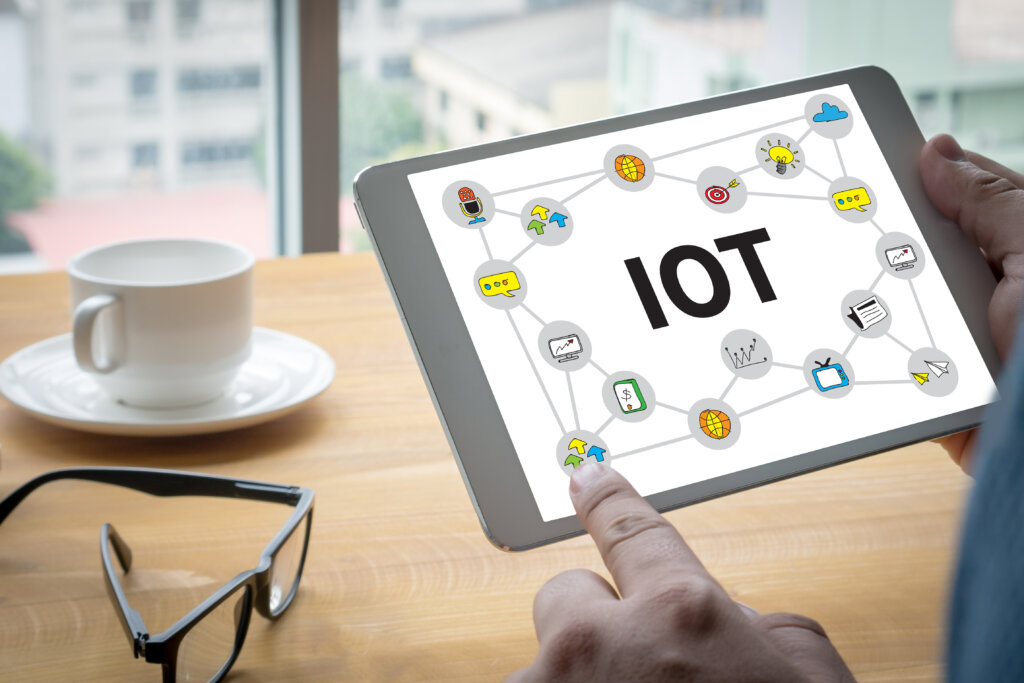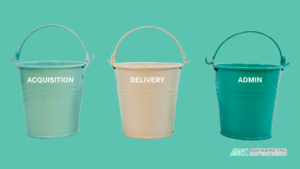The Internet of Things (IoT) has revolutionized how businesses and consumers interact, enabling a new level of data-driven decision-making.
For advertisers, this means more accurate targeting and improved customer engagement. By leveraging the power of IoT in advertising, companies can gain an edge in the increasingly competitive digital marketing landscape.
From gathering real-time consumer insights to automating ad delivery across multiple channels, here are some key game-changing benefits of integrating IoT into your advertising strategy.
What is IoT, and how does it work?
The Internet of Things (IoT) is an innovative technology revolutionizing how physical objects and digital devices interact to form a connected world.
By connecting physical items to a web of networks, such as the internet, we can allow them to interact with each other and external devices. This data exchange produces actionable insights and allows for automated processes – enhancing efficiency without sacrificing accuracy.
For advertisers, Internet of Things (IoT) devices can accumulate primary data about customer conduct and inclinations that allow them to precisely target the correct people with applicable messages when it matters.
Automated ad delivery: IoT-enabled devices can simultaneously automate ad delivery across multiple platforms. This means less manual effort for advertisers, allowing them to focus on other aspects of their marketing strategy.
Enhanced customer engagement: By leveraging data from connected devices, advertisers can provide personalized experiences that build trust and loyalty. By recognizing their preferences and interests, companies can create tailored content that resonates with their audience.
Improved ROI: IoT-enabled devices can automatically measure advertising campaign effectiveness and provide real-time performance feedback. This allows advertisers to make more informed decisions about their marketing budget and maximize profits.
Integrating IoT into your advertising strategy can revolutionize how you interact with customers and optimize your campaigns for improved results. With the right data, insight, and automation capabilities, IoT can be a powerful tool for driving growth and success in the digital age.
Improved Audience Targeting
IoT technology can provide businesses with real-time insights into their target audience’s preferences and behavior, enabling them to accurately target the right people with the right message. By tapping into this data, companies can tailor their messages to resonate with their audiences, build trust and loyalty, and achieve better results.
For example, IoT-enabled devices can track customer engagement in real-time on social media platforms like Twitter or Facebook. This allows for more precise targeting of content and campaigns across multiple channels simultaneously – increasing visibility and helping marketers reach potential customers more quickly.
In addition, businesses can use machine learning algorithms to detect when a customer is likely to buy a product or switch brands based on buying habits – allowing them to tailor ads specifically. This level of personalization helps create an individualized experience for each user – driving conversions and repeat business.
Overall, integrating IoT into your advertising strategy provides enhanced audience targeting capabilities that enable you to maximize your ROI while providing personalized experiences that build relationships with your customers over time. With the right implementation, businesses can reap the rewards of increased visibility and higher engagement levels.
Improved Performance Management
IoT technology can help businesses better manage their operations by providing real-time data analysis and feedback.
This data can be used to identify areas for improvement and optimize processes accordingly – reducing costs and increasing efficiency in the process.
Additionally, IoT technology can improve performance management by providing insight into employee performance and providing managers with the necessary data to make informed decisions and motivate employees.
By leveraging IoT solutions, companies can gain visibility into their workforce’s activities and engagement levels, allowing for more effective decision-making and improved productivity.
Finally, with an integrated platform for monitoring performance, businesses can easily detect issues or problems and take the necessary steps to resolve them quickly. This can improve performance while reducing unnecessary costs.
In summary, IoT solutions provide businesses with a comprehensive view of their operations, allowing for better decision-making, improved employee engagement, and enhanced performance management.
Personalized Advertising Experiences
IoT technology can create personalized customer experiences, helping businesses gain a competitive edge.
By gathering data on customer behaviors and preferences, companies can tailor their messaging to create individualized experiences that resonate with each user. This allows marketers to make their content more relevant and engaging – increasing conversions and sales.
Additionally, companies can use this data to identify opportunities for upselling and creating personalized offers that appeal to individual customers.
The same technology can be used to provide targeted advertising experiences.
Customized ads can be created based on a customer’s past purchases or interests, increasing the likelihood of engagement and conversion. Companies can also analyze the effectiveness of their campaigns to improve customer experiences further.
IoT technology transforms how businesses interact with customers, allowing them to create more meaningful and engaging experiences that drive conversions and sales.
With this technology, companies can provide personalized advertising experiences that appeal to users’ interests and preferences.
Examples of personalization in advertising
Examples of advertising personalization include dynamic retargeting ads to show potential customers product recommendations based on browsing history and interests.
Companies can also utilize geolocation-based marketing to deliver location-specific ads to nearby customers, such as local discounts, product launches, or exclusive offers.
Enhanced Customer Insights
IoT technology gives businesses an in-depth view of their customer base, allowing for more effective decision-making. By using customer data such as purchase history, demographic information, and browsing behavior, businesses can better understand their customers’ needs and preferences.
This deeper level of customer insights can help businesses tailor their products and services to meet their customers’ needs better, providing a more satisfying shopping experience.
Moreover, customer analytics can help businesses discover previously unconsidered target markets and create new paths toward growth. With the help of this data, companies can anticipate market trends and adjust accordingly to remain competitive.
Consequently, businesses can make more enlightened decisions that yield impressive results.
Leveraging customer insights through cutting-edge IoT technology is a surefire way for businesses to gain the upper hand in the industry, allowing them to stay ahead of their rivals.
By taking advantage of customer data, companies can offer enhanced products and services that result in heightened levels of satisfaction and devotion from customers.
Examples of insights that can be gained through IoT data
IoT data can provide businesses with a wide range of insights that can be used to improve their operations and customer service. For example, data gathered through connected devices can be used to:
- Monitor and optimize customer journeys
- Discover new demographic segments
- Track customer engagement
- Improve customer service and support
- Optimize purchase decisions
- Identify potential upsell opportunities
- Analyze product usage patterns
- Measure customer lifetime value
- Track customer sentiment and preferences
- Identify emerging trends in the market
Increased Efficiency and Cost Savings
IoT technology can help businesses optimize operations and reduce costs by automating mundane tasks. By using connected devices and sensors, companies can capture real-time data and adjust to serve their customers better.
IoT systems can detect when a machine needs maintenance or when there is an issue with production and alert the necessary personnel to address the problem before it becomes a larger issue. This improved visibility can help businesses reduce downtime, increase efficiency, and maximize productivity, resulting in cost savings.
IoT systems help businesses work better.
They help teams share information easily and quickly. This helps them work more productively. Businesses can use the connection to send data quickly and make smart choices. This will help them be successful.
In addition, IoT technology can help businesses reduce energy costs. By using connected sensors to monitor energy consumption, companies can identify areas where they waste energy and adjust their usage accordingly. This improved visibility can help businesses save money by reducing their energy costs.
Overall, IoT technology is helping businesses become more efficient and cost-effective.
By automating mundane tasks, improving communication between departments, and reducing energy costs, companies can achieve greater efficiency while saving money in the process.
Potential Challenges and Risks
Although IoT technology can have several benefits, it is not without its risks and challenges. To guarantee the safety of their data, companies must take critical measures to strengthen and secure their Internet of Things (IoT) networks against potential hacking and cyber-intrusions.
Furthermore, privacy is an important factor, given consumers’ growing concerns about the magnitude of data businesses collect. Companies must ensure that their systems possess the capacity to accommodate the immense amounts of data they will be accumulating.
Finally, companies must also consider the legal implications of using IoT technology in their business.
Depending on the area and business sector, companies must often comply with specific laws.
As such, ensuring these regulations are taken seriously when utilizing Internet of Things (IoT) technology is critical.
If not adhered to, businesses can face penalties or even legal action. Taking precautions and being mindful of regulatory requirements now will save time and money down the road!
The use of IoT technology can be beneficial for businesses and consumers alike.
However, companies must consider the potential risks and challenges of its use. Taking the necessary steps to ensure security and compliance will help companies to reap the rewards of an IoT-enabled world.
Final Thoughts
The Internet of Things is ushering in a new era of connectedness, with businesses and consumers reaping the benefits of increased efficiency and cost savings.
Companies can monitor customer journeys, track engagement, optimize purchase decisions, and measure customer lifetime value more effectively than ever before.
However, it is important to take certain steps to ensure the security and compliance of their IoT systems.
By addressing these potential challenges and risks, businesses can ensure their IoT technology is used to its fullest potential. With the right strategy in place, companies can leverage the power of IoT to unlock a world of opportunities.
About The Author
Khalid Essam
Khalid is the Chief of Staff at AOK. He collaborates with a team of specialists to develop and implement successful digital campaigns, ensuring strategic alignment and optimal results. With strong leadership skills and a passion for innovation, Khalid drives AOK’s success by staying ahead of industry trends and fostering strong client and team relationships.






